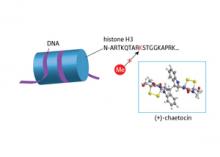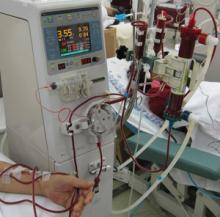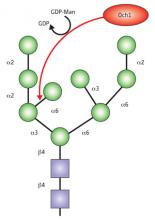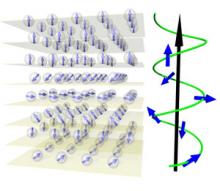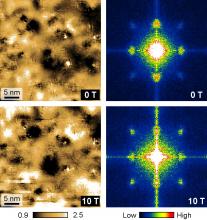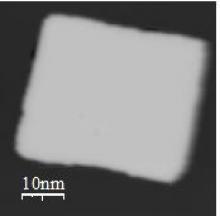Japan
News

14 May 2010
Just over 25 years ago, computer development was centered around hardware with little importance placed on software. The dominant way of thinking in Japan was that if hardware was produced, software would naturally follow. But I thought this was the wrong line of thinking.

14 May 2010
In my early student days at School of Political Science and Economics at Waseda University, I put hard work into my theoretical economics and international finance studies in order to become an elite businessman (laughing). But at the time of graduating, new jobs were scarce and I couldn’t find employment.
07 May 2010
The first total synthesis of the complex natural product chaetocin expands the tools to reverse lethal gene expressions
07 May 2010
A large-scale genetic study reveals a novel risk factor for a potentially fatal kidney disorder associated with diabetes

07 May 2010
A superconducting circuit that strongly interacts with light paves the way for optical computing schemes

30 Apr 2010
RIKEN and The University of Tokyo have partnered to release full-length human cDNA clones compiled under the Genome Network Project (GNP), an initiative of Japan’s Ministry of Education, Culture, Sports, Science and Technology (MEXT).

30 Apr 2010
Regulatory T cells can travel to and from the skin while controlling immune responses in that organ
30 Apr 2010
By characterizing the sugar content of cells, researchers have begun to reconstruct important ‘quality control’ mechanisms for protein production

26 Apr 2010
Recently whaling has received renewed attention, as has tuna fishing—attention which stems from the relative sensitivity of nations to these global environmental issues.

26 Apr 2010
There is a difference between sumo and student baseball—the former is professional and the latter amateur. It would be safe to say, then, that these sports are completely different.

26 Apr 2010
In his policy speech in October, a month after the inauguration of the new government, Prime Minister Hatoyama announced a shift from post-war politics to a politics which “protects human life and the welfare of the people”.

26 Apr 2010
It is often said that the value shared in the age of globalization is competitiveness, which is the value of the strong. In order for Japan to be a winner in a cutthroat capitalist world, Japanese society must be made truly competitive, eliminating such inefficient factors as life-time employment.

26 Apr 2010
Bob Dylan is coming to Japan. This will be the fourth time I have seen him perform in Japan, following his performances in 1994, 1997, and 2001.

26 Apr 2010
A series of affairs related to Ichiro Ozawa, the secretary general of the Democratic Party of Japan, and his secretaries has highlighted again how difficult it is to establish rules about politics and money.

26 Apr 2010
As a university teacher, I am occasionally invited to alumni weddings, and I have the opportunity to give speeches on those occasions. I am usually on the bride’s side, because the groom has ordinarily invited a senior at his company to give a speech.

26 Apr 2010
There was a report in February of this year about a plan for a five-story condominium in Ashiya city, Hyogo prefecture that did not get the required construction clearance on the grounds that the condominium would not fit in with the landscape.

26 Apr 2010
Panicked by the sharp decline in exports due to the Lehman shock, major exporters and other companies in Japan rashly made extreme reductions in production.

26 Apr 2010
Currently, media coverage of the Toyota Motor Corporation recall (recalling and repairing vehicles free of charge) is pervasive. Some of the reports are emotional, and there are shades of Toyota bashing combined with the movements to politicize the issue.

26 Apr 2010
The new iPad data terminal was announced on January 27 (local time) by Apple, Inc. With its large scale liquid crystal touch panel, you might think of it as a large version of the iPod touch.

23 Apr 2010
The RIKEN Omics Science Center (OSC) has partnered with American company Complete Genomics to develop next-generation technology for the rapid analysis of individual-level human gene expression.
23 Apr 2010
Theoretical simulations of protein structures using better computational methods provide important information on the biological functions that make life possible.
23 Apr 2010
Photoemission experiments shed light on the origin of an enigmatic type of magnetism in iron

23 Apr 2010
Therapeutic strategies that block inflammatory response to islet cell transplantation may accelerate treatment of diabetic patients
22 Apr 2010
Tokyo, 22 April - A research team at RIKEN has experimentally determined the mechanism underlying the formation of electron pairs in iron-based high-temperature superconductors. The landmark finding, reported in the April 23rd issue of Science, establishes a key role for magnetism in superconductivity.

19 Apr 2010
Keio University Shonan Fujisawa Campus (SFC) launched a website for the GIGA Program (Global Information and Communication Technology and Governance Academic Program), which is scheduled to start in the Faculty of Environment and Information Studies in September 2011.

19 Apr 2010
The 2010 Keio University Entrance Ceremony was held on Friday, 2 April at the Hiyoshi Commemorative Hall. This year, 6,728 freshmen for 10 faculties enrolled.
18 Apr 2010
Tokyo, 19 April - A research team at RIKEN has succeeded for the first time in selectively controlling for reaction products in the dissociation of a single water molecule on an ultrathin film. The reaction opens the door to the creation of novel functional catalysts and applications in clean energy production.

16 Apr 2010
Two new strategies target a deadly cancer that eludes conventional chemotherapy

16 Apr 2010
Mapping the shape and dynamics of a molecule’s outer electron cloud is now possible using a novel experimental technique

16 Apr 2010
On 19 January 2010, RIKEN and the Max Planck Society for the Advancement of Science (MPG) signed a memorandum of understanding toward the establishment of a new joint center focused on research in chemical biology.
Researchers
Sorry, no researchers coming up for this topic.
Giants in history
Ruby Sakae Hirose (1904 – 1960) was a Japanese-American scientist whose research contributed significantly to our understanding of blood clotting, allergies and cancer.
Haisako Koyama (1916 – 1997) was a Japanese solar observer whose dedication to recording sunspots – cooler parts of the sun’s surface that appear dark – produced a sunspot record of historic importance.
Michiaki Takahashi (17 February 1928 – 16 December 2013) was a Japanese virologist who developed the first chickenpox vaccine.
Toshiko Yuasa (11 December 1909 – 1 February 1980) was the first Japanese female physicist whose research on radioactivity shed light on beta decay – the process in which an atom emits a beta particle (electron) and turns into a different element.
Baron Kitasato Shibasaburo (29 January 1856 – 13 June 1931) was a Japanese physician and bacteriologist whose work led to a new understanding of preventing and treating tetanus, diphtheria and anthrax.
By isolating soil microorganisms and studying the compounds they produce, Satoshi Omura (born 1935) discovered almost 500 organic compounds with unique properties that were produced by these microorganisms, including many new antibiotics.
In 1915, pathologist Katsusaburo Yamagiwa and his research assistant Koichi Ichikawa became the first to prove that chronic exposure to chemicals can cause cancer.
In 1915, Koichi Ichikawa along with pathologist Katsusaburo Yamagiwa became the first to prove that chronic exposure to chemicals can cause cancer.
Reiji Okazaki (8 October 1930 – 1 August 1975) and Tsuneko (7 June 1933) were a Japanese couple who discovered Okazaki fragments – short sequences of DNA that are synthesized during DNA replication and linked together to form a continuous strand.
Tsuneko (7 June 1933) and Reiji Okazaki (8 October 1930 – 1 August 1975) were a Japanese couple who discovered Okazaki fragments – short sequences of DNA that are synthesized during DNA replication and linked together to form a continuous strand.
Husband and wife team, Kimishige (3 December 1925 – 6 July 2018) and Teruko Ishizaka (28 September 1926 – 4 June 2019) discovered the antibody class Immunoglobulin E (IgE) that triggers allergic reactions. They also discovered that IgE antibodies attach to white blood cells, known as mast cells, releasing histamine, which causes allergic reactions.
Husband and wife team, Kimishige (3 December 1925 – 6 July 2018) and Teruko Ishizaka (28 September 1926 – 4 June 2019) discovered the antibody class Immunoglobulin E (IgE) that triggers allergic reactions. They also discovered that IgE antibodies attach to white blood cells, known as mast cells, releasing histamine, which causes allergic reactions.
Japanese chemist Takamine Jokichi (3 November 1854 – 22 July 1922) founded the Tokyo Artificial Fertilizer Company, where he isolated a starch-digesting enzyme (named takadiastase) from the fungus Aspergillus oryzae.
Hideki Yukawa (23 January 1907 – 8 September 1981) was awarded the Nobel Prize in Physics in 1949 for predicting the existence of the pi meson subatomic particle. Japan’s first Nobel laureate, Yakawa also expressed his support for nuclear disarmament by signing the Russell–Einstein Manifesto in 1955.
Shinichiro Tomonaga (31 March 1906 – 8 July 1979), together with Richard Feynman and Julian Schwinger, was awarded the Nobel Prize in Physics in 1965, for their contributions to advance the field of quantum electrodynamics. Tomonaga was also a strong proponent of peace, who actively campaigned against the proliferation of nuclear weapons and promoted the peaceful use of nuclear energy.
Japanese chemist Kenichi Fukui (4 October 1918 – 9 January 1998) was the first Asian scientist to be awarded the Nobel Prize in Chemistry. Together with Roald Hoffman, he received this honour in 1981 for his independent research into the mechanisms of chemical reactions.
Minoru Shirota (April 23, 1899 – March 10, 1982) was a Japanese microbiologist who invented the popular fermented drink Yakult.
Japanese physicist Ukichiro Nakaya (1900-1962) made the world’s first artificial snowflakes. He started his research on snow crystals in the early 1930s at Hokkaido University, where there is an unlimited supply of natural snow in winter. By taking over 3,000 photographs, he established a classification of natural snow crystals and described their relationship with weather conditions.
The techniques that make industrial pearl culturing possible were developed over a century ago at the Misaki Marine Biological Station in Japan. The station’s first director, Professor Kakichi Mitsukuri, emphasized to Kokichi Mikimoto in 1890 that stimulating pearl sac formation was important for pearl growth, and they went on to successfully develop methods for culturing pearls.
The field of solid-state ionics originated in Europe, but Takehiko Takahashi of Nagoya University in Japan was the first to coin the term ‘solid ionics’ in 1967. ‘Solid-state ionics’ first appeared in 1971 in another of his papers, and was likely a play on ‘solid-state electronics’, another rapidly growing field at the time.
Chika Kuroda (24 March 1884 – 8 November 1968) was a Japanese chemist whose research focussed on the structures of natural pigments.
Motoo Kimura (13 November 1924 – 13 November 1994) was a Japanese theoretical population geneticist who is best remembered for developing the neutral theory of molecular evolution.
Osamu Shimomura (27 August 1928 – 19 October 2018) was a Japanese organic chemist and marine biologist who dedicated his career to understanding how organisms emitted light.
Kikunae Ikeda (8 October 1864 – 3 May 1936) was a Japanese chemist who discovered the fifth basic taste, umami.
Umetaro Suzuki (7 April 1874 – 20 September 1943) was a Japanese scientist best remembered for his research on beriberi, a disease caused by vitamin B1 deficiency, characterized by limb stiffness, paralysis and pain.
Kono Yasui (16 February 1880 – 24 March 1971) was a Japanese botanist who researched the genetics of poppies, corn and spiderworts and surveyed the plants that had been affected by the nuclear fallout after the atomic bombings of Hiroshima and Nagasaki.
Hitoshi Kihara (1893 – 1986) was one of the most famous Japanese geneticists of the 20th century. One of his most significant contributions was identifying sex chromosomes (X and Y) in flowering plants.
Michiyo Tsujimura (17 September 1888 – 1 June 1969) was a Japanese agricultural scientist and biochemist recognized for her research of green tea components.
A Japanese surgeon, Tetsuzo Akutsu (20 August 1922 – 9 August 2007) built the first artificial heart capable of keeping an animal alive.
Ogino Ginko (3 March 1851 – 23 June 1913) was the first registered female doctor to practise modern medicine in Japan.
Japanese geochemist Katsuko Saruhashi developed the first method and tools for measuring carbon dioxide in seawater


